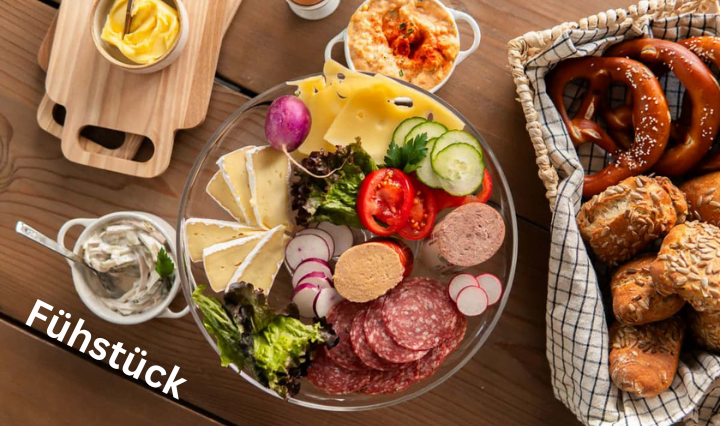In the bustling mornings of many German households, there’s a cherished tradition known as Fühstück—a hearty breakfast that sets the tone for the day ahead. Rooted in German culture, Fühstück embodies more than just a meal; it’s a ritual, a moment of connection, and a celebration of nourishment.
Contents
Origins and History
Early Origins
The concept of Fühstück traces back centuries, originating in rural German communities where farmers needed substantial morning meals to fuel their physically demanding workdays. These early breakfasts were characterized by hearty bread, cheese, meats, and eggs, providing a robust start to the day.
Evolution Over Time
As German society evolved, so did Fühstück. Industrialization brought changes in lifestyle, leading to more structured meal times and the incorporation of new ingredients like jams, cereals, and dairy products. Despite these shifts, the core essence of Fühstück remained—a wholesome, balanced start to the day.
Traditional Fühstück
Components
A typical Fühstück spread includes an array of items such as fresh bread, cold cuts, cheese, jams, honey, butter, boiled eggs, and hot beverages like coffee or tea. This combination offers a mix of carbohydrates, proteins, and fats, providing sustained energy and satiety.
Cultural Significance
Beyond its nutritional value, Fühstück holds cultural significance in German society. It serves as a time for families to gather, share stories, and connect before heading off to work or school. It’s a moment of bonding that fosters relationships and strengthens community ties.
Modern Fühstück Trends
Healthy Alternatives
In recent years, there has been a growing emphasis on healthier Fühstück options. Whole grain bread, fresh fruits, yogurt, and muesli have become popular choices, reflecting a shift towards mindful eating and wellness.
Global Influences
The globalization of food culture has also influenced Fühstück trends, with international flavors making their way onto breakfast tables. Avocado toast, smoothie bowls, and Mediterranean-inspired dishes have found their place alongside traditional German fare, adding diversity to the morning spread.
Fühstück Around the World
European Variations
While Fühstück is deeply rooted in German culture, variations of this morning meal exist across Europe. In France, it’s known as petit déjeuner, featuring croissants, coffee, and sometimes a small serving of yogurt or fruit. In Italy, colazione often includes espresso, pastries, and fresh fruit.
International Adaptations
Outside of Europe, breakfast customs vary widely. In Asia, rice, noodles, and savory dishes may be enjoyed in the morning, while in the Americas, pancakes, bacon, and eggs are staples of a hearty breakfast.
Benefits of a Balanced Fühstück
Nutritional Value
A well-rounded Fühstück provides essential nutrients needed to kick-start the day. It replenishes glycogen stores, boosts metabolism, and enhances cognitive function, setting the stage for productivity and focus.
Impact on Productivity
Studies have shown that individuals who consume a nutritious breakfast are more likely to perform better academically and professionally. By fueling both body and mind, Fühstücks can lead to increased concentration, improved mood, and higher energy levels throughout the day.
Tips for a Perfect Fühstück Experience
Planning Ahead
To ensure a stress-free morning, it’s helpful to plan Fühstücks ahead of time. Preparing ingredients the night before, such as slicing bread or chopping fruits, can streamline the breakfast routine and allow for more leisurely enjoyment in the morning.
Variety is Key
Keep Fühstücks exciting by incorporating a variety of flavors and textures. Experiment with different breads, spreads, and toppings to cater to diverse preferences and dietary needs. From sweet to savory, there’s something for everyone to savor.
Fühstück Etiquette
Social Aspects
In German culture, Fühstücks is often enjoyed leisurely, with friends or family gathered around the table. It’s a time for lively conversation, laughter, and bonding—a cherished ritual that fosters social connections and strengthens relationships.
Dining Practices
When partaking in Fühstücks, it’s customary to take your time and savor each bite. Use utensils properly, engage in polite conversation, and express gratitude for the food and company. By observing these dining practices, Fühstücks becomes not just a meal, but an experience to be savored.
Conclusion
Fühstücks is more than just a meal; it’s a cultural cornerstone that nourishes body and soul. Rooted in tradition yet adaptable to modern tastes, it brings people together and sets the stage for a productive, fulfilling day ahead. So, whether you’re indulging in a classic German spread or exploring global breakfast customs, may your Fühstück be hearty, wholesome, and shared with those you love.
FAQs
- What does “Fühstück” mean? Fühstücks is a German word that translates to “breakfast” in English.
- What are some traditional German Fühstück items? Traditional Fühstücks items include bread, cold cuts, cheese, jams, honey, butter, boiled eggs, and hot beverages like coffee or tea.
- Is Fühstück only a German tradition? While Fühstücks is deeply rooted in German culture, variations of this morning meal exist across Europe and around the world.
- How does Fühstück contribute to productivity? A balanced Fühstücks provides essential nutrients that fuel both body and mind, leading to increased concentration, improved mood, and higher energy levels throughout the day.
- What are some tips for enjoying a perfect Fühstück experience? Planning ahead, incorporating variety, and observing dining etiquette are key factors in ensuring a satisfying Fühstück experience.

1 Comment
Pingback: Understanding Cassasse: A Culinary Delight - themeganews.co.uk